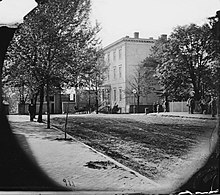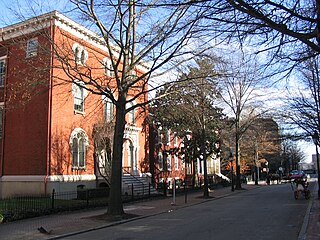
The Beauvoir estate, built in Biloxi, Mississippi, along the Gulf of Mexico, was the post-war home (1876–1889) of the former President of the Confederate States of America Jefferson Davis. The National Park Service designated the house and plantation as a National Historic Landmark.

Varina Anne Banks Howell Davis was the only First Lady of the Confederate States of America, and the longtime second wife of President Jefferson Davis. She moved to the Presidential Mansion in Richmond, Virginia, in mid-1861, and lived there for the remainder of the Civil War. Born and raised in the South and educated in Philadelphia, she had family on both sides of the conflict and unconventional views for a woman in her public role. She did not support the Confederacy's position on slavery, and was ambivalent about the war.
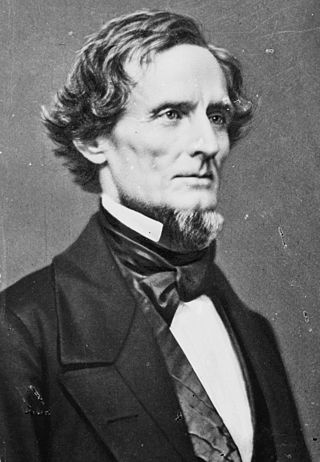
The president of the Confederate States was the head of state and head of government of the Confederate States. The president was the chief executive of the federal government and was the commander-in-chief of the Confederate Army and the Confederate Navy.

Monument Avenue is a tree-lined grassy mall dividing the eastbound and westbound traffic in Richmond, Virginia, originally named for its emblematic complex of structures honoring those who fought for the Confederacy during the American Civil War. Between 1900 and 1925, Monument Avenue greatly expanded with architecturally significant houses, churches, and apartment buildings. Four of the bronze statues representing J. E. B. Stuart, Stonewall Jackson, Jefferson Davis and Matthew Fontaine Maury were removed from their memorial pedestals amidst civil unrest in July 2020. The Robert E. Lee monument was handled differently as it was owned by the Commonwealth, in contrast with the other monuments which were owned by the city. Dedicated in 1890, it was removed on September 8, 2021. All these monuments, including their pedestals, have now been removed completely from the Avenue. The last remaining statue on Monument Avenue is the Arthur Ashe Monument, memorializing the African-American tennis champion, dedicated in 1996.

The American Civil War Museum is a multi-site museum in the Greater Richmond Region of central Virginia, dedicated to the history of the American Civil War. The museum operates three sites: The White House of the Confederacy, American Civil War Museum at Historic Tredegar in Richmond, and American Civil War Museum at Appomattox. It maintains a comprehensive collection of artifacts, manuscripts, Confederate books and pamphlets, and photographs.
John Brockenbrough (1775–1852) was a business man and civic leader in Richmond, Virginia. He was president of the Bank of Virginia. His home in Richmond's Court End District later served as the White House of the Confederacy.

The Virginia State Capitol is the seat of state government of the Commonwealth of Virginia, located in Richmond, the state capital. It houses the oldest elected legislative body in North America, the Virginia General Assembly, first established as the House of Burgesses in 1619.

The Alabama State Capitol, listed on the National Register of Historic Places as the First Confederate Capitol, is the state capitol building for Alabama. Located on Capitol Hill, originally Goat Hill, in Montgomery, it was declared a National Historic Landmark on December 19, 1960. Unlike every other state capitol, the Alabama Legislature does not meet there, but at the Alabama State House. The Capitol has the governor's office and otherwise functions as a museum.
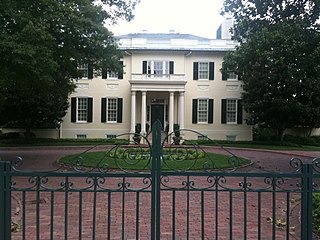
The Virginia Governor's Mansion, better known as the Executive Mansion, is located in Richmond, Virginia, on Capitol Square and serves as the official residence of the governor of the Commonwealth of Virginia. Designed by Alexander Parris, it is the oldest occupied governor's mansion in the United States. It has served as the home of Virginia governors and their families since 1813. This mansion is both a Virginia and a National Historic Landmark, and has had a number of successive renovations and expansions during the 20th century.

William Thomas Sutherlin was a tobacco planter, distributor, industrialist, Confederate quartermaster and politician. He served as mayor of Danville, Virginia (1855-1861), as its delegate to the Virginia Secession Convention of 1861 and later for one term in the Virginia House of Delegates (1871-1873) Sutherlin's plantation home became the temporary residence for President of the Confederate States of America Jefferson Davis and his Cabinet from April 3 – April 10, 1865, the week before Gen. Robert E. Lee surrendered the Army of Northern Virginia at Appomattox Courthouse.
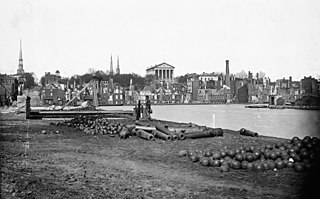
Richmond, Virginia served as the capital of the Confederate States of America during the American Civil War from May 8, 1861, hitherto the capital had been Montgomery, Alabama. Notwithstanding its political status, it was a vital source of weapons and supplies for the war effort, as well as the terminus of five railroads, and as such would have been defended by the Confederate States Army at all costs.
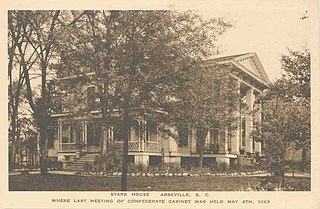
The Burt-Stark Mansion, also known as Armistead Burt House, in Abbeville, South Carolina was the site of the last Council of War of cabinet members of the Confederate government. On May 2, 1865, Jefferson Davis, hoping to continue the struggle, met unanimous opposition and realized the Confederate independence cause was lost.

The First White House of the Confederacy was the initial executive residence of President of the Confederate States of America Jefferson Davis and family while the capital of the Confederate States of America was in Montgomery, Alabama. Completely furnished with original period pieces from the 1850s and 1860s, the 1835 Italianate-style house is open to the public. It has been listed on the National Register of Historic Places since 1974 and the Alabama Register of Landmarks and Heritage since 2012.
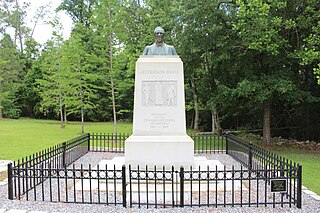
Jefferson Davis Memorial Historic Site is a 12.668-acre (5.127 ha) state historic site located in Irwin County, Georgia that marks the spot where Confederate States President Jefferson Davis was captured by United States Cavalry on Wednesday, May 10, 1865. The historic site features a granite monument with a bronze bust of Davis that is located at the place of capture. The memorial museum, built in 1939 by the Works Progress Administration, features Civil War era weapons, uniforms, artifacts and an exhibit about the president's 1865 flight from Richmond, Virginia to Irwin County, Georgia.

Ellerslie is an historic home located at Colonial Heights, Virginia. It is a large 2+1⁄2-story, hip-roofed, Italian Villa style dwelling with a two-story rear service wing connected by an arcade. It features a three-story tower with a hipped roof and a full-width front porch.

Danville Museum of Fine Arts and History, also known as the William T. Sutherlin Mansion and the Confederate Memorial, is a historic home and museum building located at Danville, Virginia. It was built for Major William T. Sutherlin in 1857–1858, and is a two-story, five-bay, stuccoed building in the Italian Villa style. It features a one-story wooden porch, a shallow hipped roof surrounded by a heavy bracketed cornice and topped by a square cupola ornamented with pilasters and a bracketed cornice.
The Civil War Trust's Civil War Discovery Trail is a heritage tourism program that links more than 600 U.S. Civil War sites in more than 30 states. The program is one of the White House Millennium Council's sixteen flagship National Millennium Trails. Sites on the trail include battlefields, museums, historic sites, forts and cemeteries.



